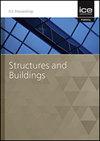层压竹材上机械紧固件的回撤性能
IF 1.4
4区 工程技术
Q3 CONSTRUCTION & BUILDING TECHNOLOGY
Proceedings of the Institution of Civil Engineers-Structures and Buildings
Pub Date : 2022-10-10
DOI:10.1680/jstbu.22.00118
引用次数: 0
摘要
通过连接试验,研究了杆径、杆型、插接深度和插接方向对竹材夹钉性能的影响。研究发现,紧固件的杆型对其失效模式有显著影响。钉子直接从LBL中拔出,由于柄光滑,无其他可见损伤,螺钉周围的竹纤维在螺纹作用下被撕裂。在最大荷载前,试件的荷载-滑移曲线呈线性关系,此时紧固件与LBL之间的相对滑移较小。然而,在曲线的下降部分,钉子和螺钉的峰后性能变化显著。平行于晶粒方向钉入的试件拔钉能力最低,切向钉入的试件拔钉能力次之,径向钉入的试件拔钉能力最差。随着埋深和杆径的增加,试件的回撤能力呈线性增加。记录了实测荷载-滑移曲线,并与现有理论模型进行了比较。结果表明,Yuan和Ling模型可分别用于预测LBL中钉和螺钉的拉拔行为的荷载-滑移关系。本文章由计算机程序翻译,如有差异,请以英文原文为准。
Withdrawal behaviour of mechanical fasteners on laminated bamboo lumber
Experiments on connections were done to evaluate the effect of shank diameter, shank type, penetration depth, and insertion direction on the nail-holding behaviour of laminated bamboo lumber (LBL). It is found that shank type of fasteners has significant effect on failure modes. Nails were pulled out directly from the LBL without other visible damage due to smooth shank, while the bamboo fibers around the screws were tore under the action of screw thread. The load-slip curves of specimens are linear up to the maximum load and relative slip between the fasteners and LBL is small at this stage. However, the post-peak performance of nails and screws varies significantly on the descending portion of the curves. The specimens with nails inserted parallel to grain have the lowest withdrawal capacity, followed by those of the tangential and radial directions. As expected, the withdrawal capacity of the specimens increases linearly with the increase of the embedment depth and shank diameter. The measured load-slip curves were recorded and compared with the existing theoretical models. Results show that the Yuan and Ling model can be used to predict the load-slip relationship of the withdrawal behaviour of nails and screws in LBL respectively.
求助全文
通过发布文献求助,成功后即可免费获取论文全文。
去求助
来源期刊
CiteScore
3.40
自引率
6.20%
发文量
61
审稿时长
12 months
期刊介绍:
Structures and Buildings publishes peer-reviewed papers on the design and construction of civil engineering structures and the applied research associated with such activities. Topics include the design, strength, durability and behaviour of structural components and systems.
Topics covered: energy conservation, people movement within and around buildings, strength and durability of steel and concrete structural components, and the behaviour of building and bridge components and systems

 求助内容:
求助内容: 应助结果提醒方式:
应助结果提醒方式:


